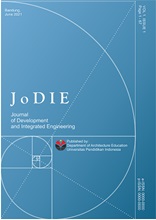Hotel's Role in Enhancing Accommodation to Support Tourism in Cirebon City
Abstract
This research explores the role of hotel design in enhancing accommodation to support tourism in Cirebon City. Tourism is an important sector that contributes to national foreign exchange, regional income, and job creation. Cirebon City, with its rich culture and history, has become a major tourist destination in West Java, attracting both local and international tourists. Despite significant growth in this sector, the main challenge faced is the lack of adequate accommodation to meet the needs of tourists, which often reduces the duration of visits or leads to the cancellation of their travel plans. This study aims to formulate hotel design strategies that can improve the quality and capacity of accommodation in Cirebon. The research methodology uses a qualitative approach with descriptive analysis and field surveys. The research findings indicate that innovative hotel design, which integrates local cultural characteristics and environmental sustainability principles, enhances tourist attraction and strengthens Cirebon's image as a unique and appealing tourist destination. The projected hotel demand until 2028 shows a significant increase in the number of tourists, requiring an increase in accommodation capacity from 3-star and 4-star hotels.
The development plan includes the construction of 3-star and 4-star hotels, each designed to meet the needs of different tourist segments. The implementation of design that emphasizes comfort, adequate facilities, and local cultural elements is expected to improve the quality of tourist experiences, promote local economic growth, create jobs, and preserve Cirebon's cultural heritage. This study concludes that effective hotel design that is responsive to the needs of tourists and the environment is key to supporting sustainable tourism development in Cirebon City..
Full Text:
PDFReferences
Abdillah, D. (2016). Pengembangan Wisata Bahari di Pesisir Pantai Teluk Lampung. Jurnal Destinasi Kepariwisataan Indonesia.
Amrin Conoras, M. M. (2017). PENERAPAN PRINSIP WATERFRONT CITY PADA OBJEK WISATA PANTAI AKE SAHU KOTA TIDORE KEPULAUAN. Jurnal Archipelascape, 3(1).
Andi Rif, A. (2018). DAYA TARIK WISATA PANTAI WEDIOMBO SEBAGAI ALTERNATIF WISATA BAHARI DI DAERAH ISTIMEWA YOGYAKARTA. Jurnal Geografi, 10(1). http://jurnal.unimed.ac.id/2012/index.php/geo
Baud-Bovy, M., & Lawson, F. R. (1998). Tourism and Recreation Handbook of Planning and Design (2nd ed.). Architectural Press.
BPS Kota CIrebon. (2024). KOTA CIREBON DALAM ANGKA CIREBON.
Collins, D. (2001). New Hotel Architecture and Design. Conran Octopus Publishing Group.
Dinas Pariwisata dan Kebudayaan Kota Cirebon. (2024). Data Pariwisata Kota Cirebon Tahun 2023.
Hilal, R. (2011). Kajian Teori Pengertian hotel.
Inskeep, E. (1991). Tourism Planning and Integrated Sustainable Development Approach. Van Nostrand Reinhold.
Kep Dirjen Pariwisata no 14/U/II88 . (1988).
Khofif, D. R. (2021). The Concept of Sustainable Tourism in Cultural Heritage Preservation. Jurnal Pariwisata Terapan, 5(1).
Kristiawan, Y. B., & Pramudito, S. (2022). Identifikasi Logika-logika Arsitektur Berkelanjutan Dalam Penelitian dan Praktek Berarsitektur. Jurnal Arsitektur Arcade, 6(1). https://e-jurnal.ukri.ac.id/index.php/arcade/about/editorialTeam
Lawson, F. (2004). Hotel and Resort, Planning Design and Refurbisment. Architectural Press.
Mamengko, R. P., Erlina, D., & Kuntari, D. (2020). PENGELOLAAN PARIWISATA BAHARI BERBASIS COMMUNITY-BASED TOURISM DALAM PENINGKATAN EKONOMI MASYARAKAT PESISIR. 18(1). https://doi.org/10.36275/mws
Permana, A. Y., Susanti, I., & Wijaya, K. (2020). Architectural Tourism Development Model as Sustainable Tourism Concept in Bandung. IOP Conference Series: Earth and Environmental Science, 409(1). https://doi.org/10.1088/1755-1315/409/1/012005
DOI: https://doi.org/10.17509/jodie.v4i1.70946
Refbacks
- There are currently no refbacks.
Copyright (c) 2025 Seto Maulana Mahendra, Juang Akbardin

This work is licensed under a Creative Commons Attribution-NonCommercial-ShareAlike 4.0 International License.

This work is licensed under a Creative Commons Attribution-ShareAlike 4.0 International License.








